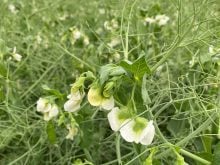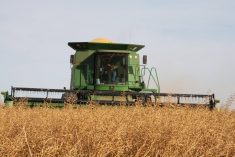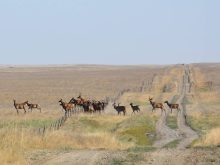Controlling biting insects such as flies and mosquitoes can be difficult and expensive.
Area-wide management programs that involve treating rivers and streams with microbial insecticides have been successful, but require good timing and co-ordination. More localized management practices include smoky fires to repel flies and moving cattle away from aquatic sources of infestation.
When considering insect control options for cattle, producers should calculate potential costs and logistics and the amount of stress on the animal.
Spray concentrates
Spray concentrate formulations include emulsifiable concentrates, flowables and wettable powders that are diluted before the application.
Read Also

Crop quality looks good this year across Prairies
Crop quality looks real good this year, with the exception of durum.
Most concentrates are diluted with a large amount of water and applied with high pressure equipment to provide a coarse spray. The objective is to wet the animal thoroughly. A few concentrates can be diluted with low volume oil solvents and applied as a fine mist to moisten the animal’s surface.
Spray treatments offer the advantage of complete body coverage. They usually provide good initial control, but their residual effectiveness may be short lived. To spray cattle, producers need a corral, application equipment and a source of water.
Pour-ons and spot-ons
Pour-ons are formulated so a small amount of insecticide can be applied on an animal’s spine. Most are ready to use and require no further dilution. Some pour-ons are systemic insecticides that move into the animal and circulate through the body. Other non-systemic products spread across the body surface with body oils and moisture.
A spot-on differs only in that a small amount of material is applied at one location on the spine.
Pour-ons are easy to use and allow an exact dosage to be applied to each animal. To apply, producers will need a corral and squeeze chute. Some pour-ons can be more easily applied with a syringe gun. Residual effectiveness varies, but it is usually measured in two or more weeks.
Insecticide ear tags
Ear tags can be impregnated with insecticide concentrate that is slowly released over an extended period.
The tag is a controlled-released applicator, but the amount of insecticide that is released decreases over time.
Ear tags are not systemic. Instead, the insecticide is spread over the body as animals groom themselves and rub against each other.
Producers will need an ear tag applicator, corral and a squeeze chute with a head gate.
Ear tags can be labour intensive, especially the first time cattle are tagged, but they can also be cost effective. A good tag can provide three to four months’ control of a susceptible target pest.
Dusts
Dust formulations combine a low concentration of active insecticide with a dust diluting agent. They can be applied with hand shakers, mechanical applicators and self-treatment dust bags.
Feed-throughs
Feed-throughs combine a small dose of insecticide or insect growth regulator with cattle feed or minerals. Most are mixed and formulated by the feed or mineral supply company.
Insecticide boluses can also be classified as a feed-through.
Feed-through chemicals pass through the animal’s digestive system and are excreted in the manure. The chemicals control fly maggots or the larval stage of the adult fly. They do not control adult flies.
Feed and minerals must be consumed continuously during the fly season so that cattle manure is always treated.
Self-treatment back rubbers
Back rubbers can be built by wrapping burlap bags around a cable or chain and hung where cattle can pass under them. They are charged with insecticide concentrates that are diluted with approved base oils following label instructions.
Apply one gallon of diluted solution per 20 feet of homemade burlap back rubber.
To get maximum benefits, place them in alleys or locations where cattle must pass regularly, such as between cattle and their feed, water or minerals. Free choice locations do not ensure regular use, but cattle can learn to use a back rubber in a shady, loafing area.
Their effectiveness is determined not only by the insecticide but by frequency of use.
Dust bags
This self-treatment device operates under the same principle as a back rubber. Weatherproof dust bags are commercially available, but high humidity and steamy weather sometimes impair their effectiveness.
Weigh scale reader
The Mettler-Toldeo Jagxtreme graphical operator interface is designed to provide a visual readout of weighing applications.
The monitor is easy to use and allows operators to rapidly and intuitively manage their weighing tasks. The display monitor offers 256 background and foreground colours. It comes with ethernet, PS2 keyboard port and RS232 serial port connections and can easily be adapted to local- or wide-area networks.
For more information, write to Mettler-Toledo Inc., 1900 Polaris Parkway, Columbus, Ohio, U.S.A., 43240-4035, call 800-523-5123 or visit www.mt.com.
Flexible work glove
The Pro Dex 500 work glove by Gorgonz is form fitting and designed for people who handle small objects and require maximum dexterity.
The tips of the thumb and two fingers have been removed, allowing wearers to handle small objects and perform intricate tasks without removing the gloves. They are made of breathable Toughtek fabric and feature reinforced leather palms, adjustable Velcro wrist straps and Neoprene knuckle protection.
For more information, write to Gorgonz Performance Work Gear, 701 East Pratt Street, Suite 180, Baltimore, Maryland, U.S.A., 21202-3101, call 877-725-4386 or visit www.gorgonz.com.
Rodent poison
A new rodenticide is designed to address severe ground squirrel problems on farms, acreages, commercial properties, parks and residential areas.
Exit is an environmentally friendly, pest specific product designed to control ground squirrels but not eliminate the species.
The product is biodegradable and poses no threat to scavenging birds and animals.
It has a high efficacy rate and acts quickly. About 99 percent of gophers will remain in their burrows after an Exit treatment.
For more information on Exit, write to GNC Holdings, Rodent Control Services, 653 Cuelenaere Street, Prince Albert, Sask., S6V 2T1 or call 306-764-5042.














